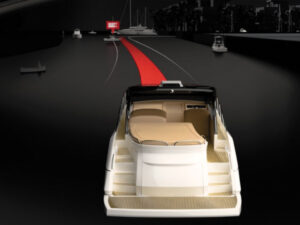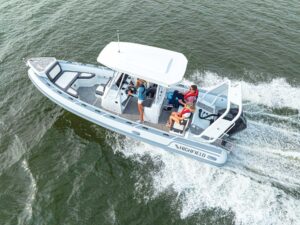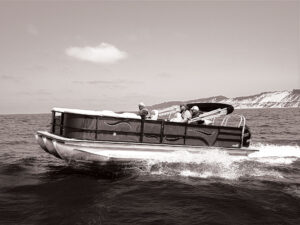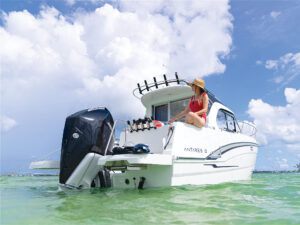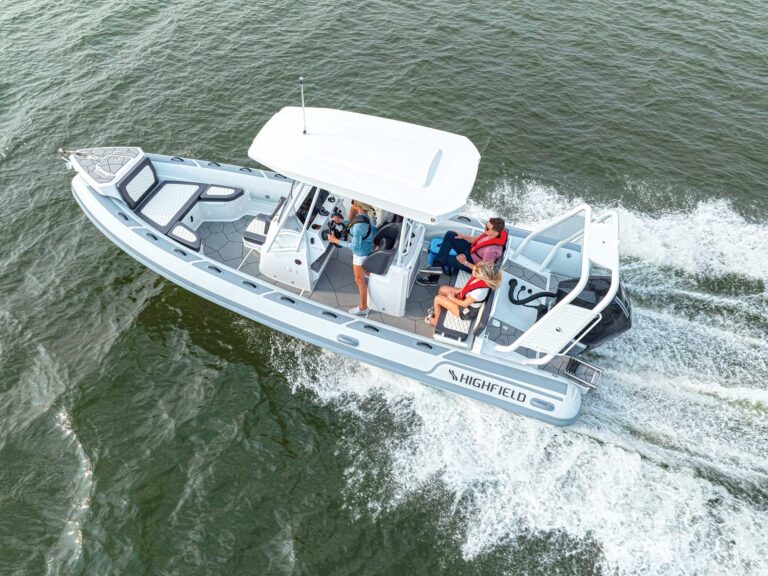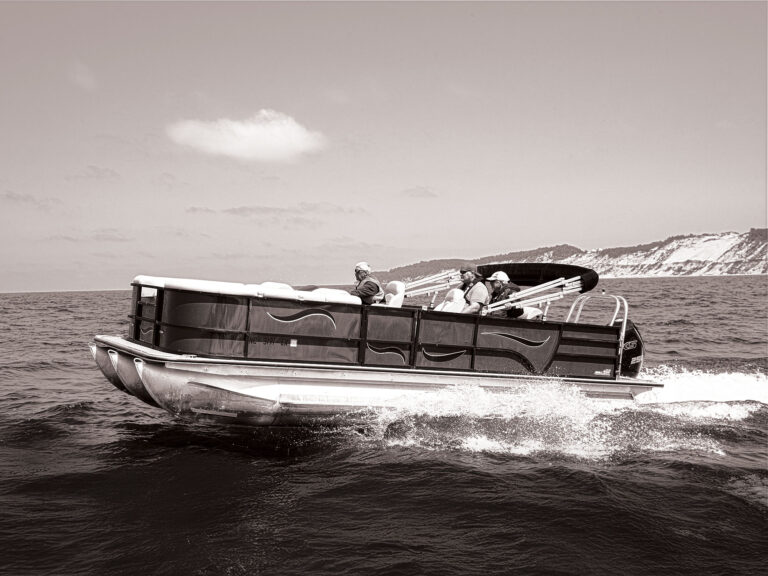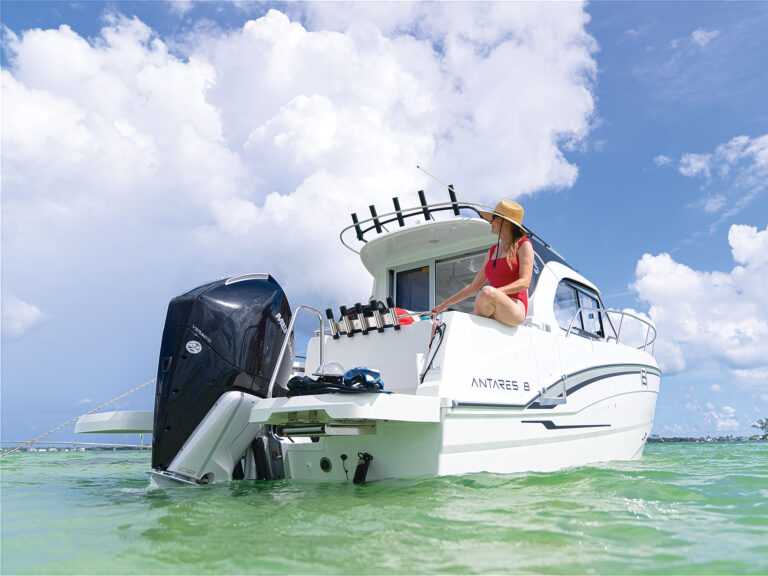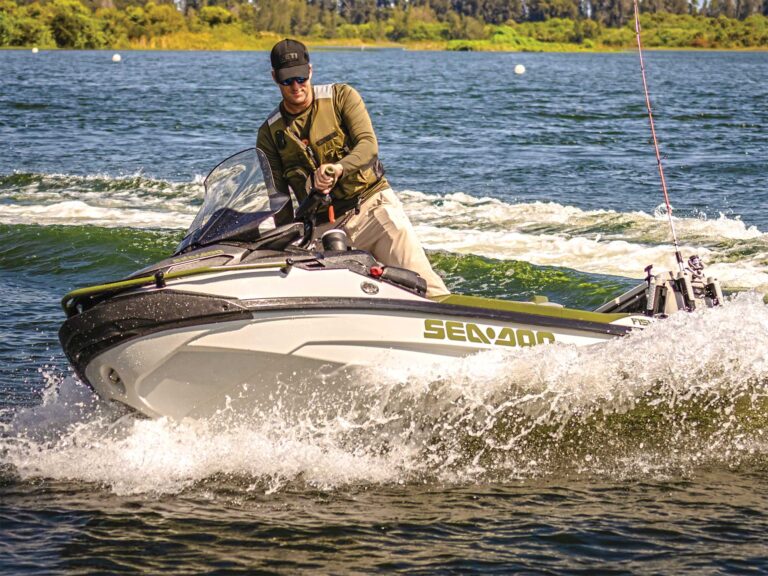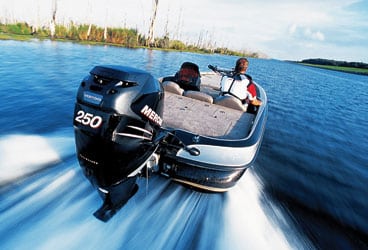
6 Burning Questions About Outboards
For many kinds of boating, the outboard motor is the answer. But it comes with questions, too — which is better, two strokes or four? What’s the right prop? Is the bigger motor the better motor? We’ve presented a few of the most debated questions to the experts, and here’s how they answer them.
Are four-strokes always better than two-stroke engines?
Answer: Are Fords better than Chevrolets? When it comes to outboard motors, the question is four-stroke vs. two-stroke. If you believe what you hear, the answer is etched across the stone board — four-strokes rule. But dig deeper and you find the answer isn’t so clear.
First, the technical distinction and difference between two-stroke and four-stroke engines. Four-stroke outboards, like the engine in the car in your driveway, burn straight gasoline within cylinders, circulating lubricating oil through a separate system. Oil and gas don’t mix, unless there’s a breakdown. Two-stroke engines, in contrast, burn a blend of gas and oil.
Traditional two-strokes were fed their oil-gas mix fuel by carburetor or injector into the cylinder through an intake valve. During part of this feeding, the exhaust valve was also open, and up to 30 percent of the fuel escaped unburned.
Jump ahead to two-stroke direct-fuel-injection (DFI) engines. The fuel is sprayed into the cylinder with precision timing while the piston covers the exhaust valve. There’s no loss of fuel. (In four-stroke engines, thanks to their four piston strokes per cycle, intake and exhaust take place at separate times.) DFI two-strokes and four-strokes both deliver much better fuel economy than traditional two-strokes, since they’re directed by computer and burn virtually all of the fuel.
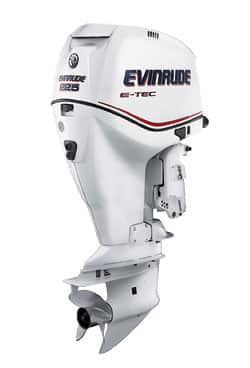
6 Burning Questions About Outboards
Evinrude’s E-TEC two-stroke DFI engines inject fuel twice as fast as standard direct injection, even adjusting the fuel delivery and oil-gas mix as needed. We’ve tested the E-TEC engines, and they’re just as smooth and almost as quiet as four-strokes while maintaining more traditional two-stroke power.
On the other side, four-stroke motors are also erasing what was a clear division just two years ago, the one that said two-strokes are inherently more powerful. The industry once envisioned a 100-horsepower limit for four-strokes because of their extra weight. But the limit has vanished. Witness Suzuki’s 300-horsepower four-stroke at just 604 pounds.
“It’s a closer call than ever before,” says Mercury spokesperson Eric Pope. “The biggest myth is the idea that two-strokes are noisy, smelly and not very fuel efficient. It isn’t true today.”
Two versus four is now more a matter of boater preferences than ground-shaking practical distinctions. Through it all, both modern four-strokes and DFI two-strokes are mechanical marvels.
The Differences in Performance Between Two-Stroke and Four-Stroke Engines Are Shrinking
• Two-stroke DFIs are lighter than four-strokes with the same power, but the difference is shrinking.
• Four-strokes are quieter than two-strokes, but the difference is shrinking.
• Two-strokes generally provide a stronger hole shot, but the difference is shrinking.
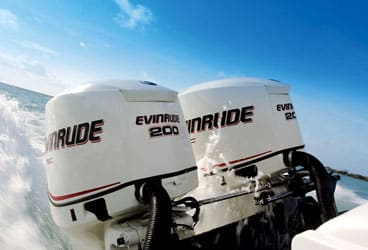
6 Burning Questions About Outboards
Are two motors better than one?
You’ll mainly see duals (and triples) in offshore fishing applications. In most cases you can bet they’ve been installed for peace of mind for boaters who have visions of catastrophic loss of an engine at sea. Duals have also earned favor for making docking an easier task, thanks to the engines having props revolving in opposite directions.
But for this protection against an unlikely event, and for simpler steering dockside, a boater pays more money upfront — a lot more. Rigging with a pair of motors means you have to duplicate the controls and generally complicates installation.
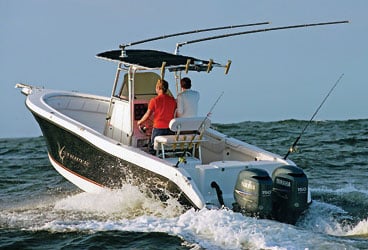
6 Burning Questions About Outboards
“In performance, it’s a wash,” says Suzuki spokesman Rick Hauser. “Three hundred horses are three hundred horses, whether it comes through one prop or two.”
It really comes down to economics. If the price difference is not an issue, then twins are worth considering. Otherwise, a single is the simpler call.
Why Two Outboards Might Not Be Better Than One
• Multiple motors only provide security against breakdown if they’re truly independent, including fuel and power sources.
• Hanging multiple motors adds power only if they exceed the power available in a single.
• Another alternative is to run a single unit and add a satellite phone for breakdown recourse.
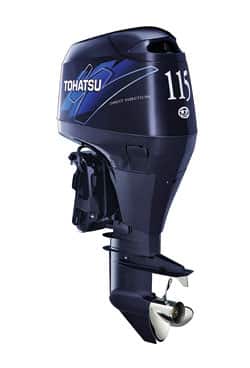
Is High Octane Gas the Best for my Engine?
Answer: When high-compression engines came on the scene, the increased pressure in their cylinders sometimes caused fuel to explode too early. That preignition, called spark knock, was more than an irritating noise (although certainly that); it caused engine damage.
The solution was to add materials to the fuel that would slow the ignition until the piston was ready for the spark plug to activate, which would avoid damage and make efficient use of that higher compression. So now, the higher the octane rating, the better the fuel can handle compression.
Sounds good. But the truth is high-octane fuel — usually 92 or 93 octane — is a waste of money for the majority of outboards. Most are built to run happily on 87 octane. Some manufacturers — such as Tohatsu — do recommend midrange fuel, usually 89 octane. Check your owner’s manual, and fuel up with what it prescribes. Go above the recommended octane and you’re giving away about 20 to 30 cents per gallon.
High Octane Gas is Probably Not Necessary for your Outboard Engine
• Only high-performance engines need high-octane fuel.
• High-octane fuel in motors made for low-octane fuel nets no better performance, but bigger fuel bills.
• In a few cases, motor makers might prescribe midrange fuel, usually 89 octane.
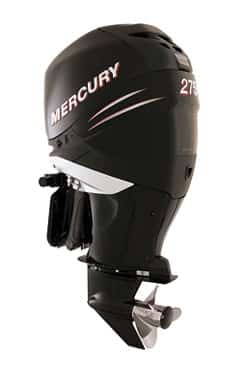
What Size Outboard Motor do I Need?
Answer: Boat buyers years ago were made rightfully leery of boat packages when some dealers priced them with puny outboards, and then coached the consumer up to a more respectable power plant before closing the deal. Those who spent the extra bucks for a bigger motor were generally well-served; those who stayed with a small motor for the lower price point were often disappointed.
Things are better now: There are fewer underpowered packages on the market. Still, bigger is generally better.
One of the worst things you can do is under-power a boat. You’ll never savor the performance built into the hull. You won’t be as prepared to scoot from an approaching storm. Potential buyers of your boat down the road will cast a jaundiced eye.
Going with the boat maker’s maximum rating, found on the inspection plate, is a pretty safe bet. If you’re on the fence, you can check with boat manufacturers, who generally have available test data on the boat of your choice powered with various makes and models of engines.
Why a Larger Outboard Engine Makes Sense
• Take sea trials with boats that have less-than-max motors. We’ve noted in tests that some smaller motors power boats — particularly pontoons — beautifully.
• For the biggest seas and the heaviest loads, you want the biggest boy on the back of the boat.
• When was the last time you heard someone say they bought a boat with too large a motor?
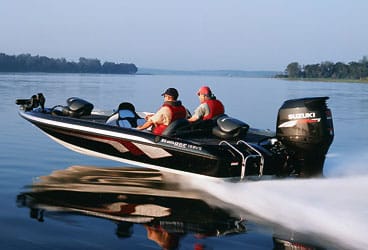
How do I get the Right Prop for my Engine?
Answer: The maker of your outboard probably equipped it with a decent, middle-of-the-road propeller. If not, the dealer likely did. But if either of them installed the perfect prop for you, it was probably dumb luck: The correct prop depends on how you’ll load your boat, and how you’ll use it.
First, some propeller basics. Props are measured in diameter and pitch. You remember diameter from high-school geometry, of course, but pitch? Propeller pitch is the theoretical distance the propeller would travel through one complete revolution if there was no slippage.
Moving away from the prop itself for a minute, consider that engine manufacturers rate their product’s horsepower at a specific rpm, setting rpm ranges for top-end operation. It can only hit that top-end bracket if it’s powering the right propeller. If the prop allows the motor to over-rev, then wear and friction can occur. If the propeller restrains the motor from reaching that prime range, it gets poor mileage and you risk other damage. You can protect your motor and improve its performance by picking the right pitch.
You can test your prop by running your boat at wide-open throttle. (If you’re over the maximum rpm, throttle down until the needle is within the manufacturer-suggested range.) Ashore, inspect the propeller to learn its pitch. Figuring that you get about a 200 rpm drop for each increase in pitch, try a different prop. A cupped propeller will also reduce rpm by about 200. Some dealers will even let you test a prop, provided you return it undamaged and promptly.
As long as it hits but doesn’t exceed the motor’s top-end range, a prop delivering wide-open rpms toward the bottom of the range provides stronger hole shots, while those toward the top generate slightly higher top speeds.
What to Know About Boat Engine Propellers
• Prop condition can be more important than type: A damaged prop can destroy the engine spinning it.
• Stainless-steel props run truest and are five times as strong, but aluminum is cheaper and sacrifices itself to protect the lower unit.
• A four-blade prop beats a three-blade in time to plane, midrange speed and low-speed handling.
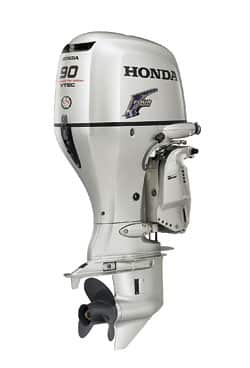
6 Burning Questions About Outboards
How Much Maintenance is Necessary on my Outboard Engine?
Answer: There is little you need to do to maintain an outboard motor — but what is still needed is vitally important. You can blow up an engine by neglecting its cooling needs, clog it up by ignoring potential fuel problems, bust it up by letting the lower unit sit over winter with leaky seals. Depleted zincs can invite corrosion. Dinged props can shake the stuffing out of bearings and other moving parts. Owner’s manuals have slim maintenance sections. That doesn’t mean they’re unimportant.
Easy Outboard Engine Maintenance Tips
• Keep the fuel tank topped to reduce the chances of condensation building up when the motor isn’t in use.
• Add fuel stabilizer every time you add fuel — it’s important now with ethanol fuels.
• Inspect the prop at every opportunity. A ding might cause chatter at cruising speeds, but a tiny one could go unnoticed — and still do damage.
• Look over the fittings and hoses; cool water needs to run through the motor to keep it from burning up.

